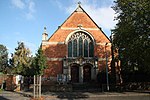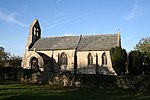Heckington Windmill
1830 establishments in EnglandGrade I listed buildings in LincolnshireGrade I listed windmillsGrinding mills in the United KingdomMill museums in England ... and 5 more
Museums in LincolnshireTower mills in the United KingdomUse British English from February 2023Windmills completed in 1830Windmills in Lincolnshire

Heckington Windmill is the only eight-sailed tower windmill still standing in the United Kingdom with its sails intact. Heckington is located between Sleaford and Boston in Lincolnshire, England. The mill stands very close to Heckington railway station, hence its name of the 'Station Mill' in the 19th century. The windmill is designated a Grade I listed building.
Excerpt from the Wikipedia article Heckington Windmill (License: CC BY-SA 3.0, Authors, Images).Heckington Windmill
Hale Road, North Kesteven Heckington
Geographical coordinates (GPS) Address Phone number Website External links Nearby Places Show on map
Geographical coordinates (GPS)
| Latitude | Longitude |
|---|---|
| N 52.977059 ° | E -0.29521 ° |
Address
Heckington Windmill
Hale Road
NG34 9JW North Kesteven, Heckington
England, United Kingdom
Open on Google Maps








